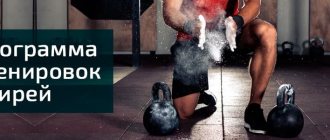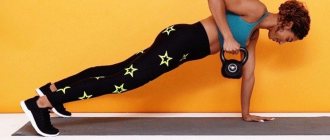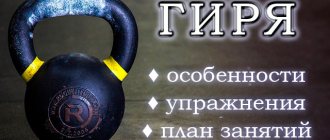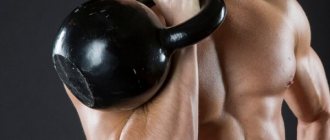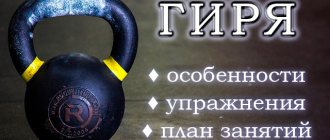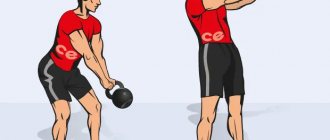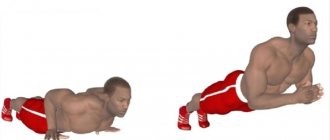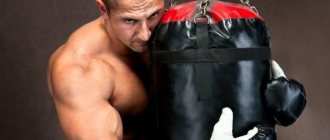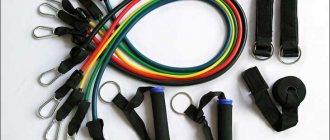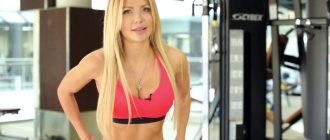Hello friends, why do you need kettlebell exercises for boxers? After all, these athletes already have a lot of equipment and loads. In addition, they are not weightlifters and must be fast and mobile.
This article addresses the following questions:
- how to train a boxer with a kettlebell,
- what nuances are taken into account?
- what are the advantages of this process.
Training with Kettlebells for Boxing
POST FROM HONORABLE GUEST SPIRO - Certified Kettlebell Instructor!
I have a task for you: go to Google and search for the term 'weights'. Then open a few of the pages that light up, and try not to think that these 'cannonballs with a handle' (a new platitude born every minute...) are some kind of divine gift to humanity.
I bet you'll read articles that promise you serious muscle growth, a stronger core, 'burning' fat and incredible physique. You'll also find a few references to old-school Russian heroes who eat iron nails instead of spinach, the notorious special forces, and - who knows? – perhaps even to Rasputin and Stalin!
Benefits of the kettlebell
A boxer can do a set of strength exercises using dumbbells and barbells. But thanks to the kettlebell, there is an additional load on the muscles. The reasons for this lie in the following:
- This projectile has very thick handles. This makes coverage difficult.
- Special position of the weight in relation to the handle.
In some clubs, kettlebell trainers work with boxers. Although this function is often performed by a general training coach. One way or another, personal training programs are drawn up.
Important points
The power of a punch depends not only on muscle development, but also on the correct technique. Strength is determined by speed and the athlete's ability to use his own body weight to achieve it. When striking with a fist, it is important to observe the following rules:
- the hand with the fist is never fully straightened, otherwise there is a high risk of dislocation;
- the feet are placed wider than the shoulders, the turn is made in the direction of movement and the heel comes off the floor first;
- When striking with the right fist, the left foot should not move; a similar rule applies to the left limb;
- The knees should be slightly bent, which makes it possible to transfer the weight forward.
When striking in close contact, the increase in force ensures maximum use of the entire body. At the moment of collision, the fist should be closed as tightly as possible.
A set of exercises to increase impact power is selected individually. A large list of them allows you to choose the best option for training at home or in the gym. If desired, you can give preference to basic exercises without the use of equipment or use sports equipment and sports training equipment. An important requirement for obtaining the desired result is to provide a complex load on various muscle groups.
List of effective exercises
To develop the strength and power of the fist, there are many exercises, among which you can choose options for beginners and experienced athletes. Increased strength can be achieved by exercising even at home, since most effective exercises do not require complex sports equipment. A set of exercises at home and in the gym may include:
- exercises using your own weight;
- the use of weights, weights, barbells and special belts;
- use of a sports bench;
- exercises on an expander, jumping rope;
- choosing a horizontal bar, crossbars or exercise equipment.
When choosing a program for developing arms and increasing fist strength, it is necessary to take into account the level of training and existing contraindications for working with weights and other equipment. Best exercises for punching strength:
- straight push-ups on fists - performed on a flat, hard surface using several approaches, the number of which is determined individually; to increase the load, the hands are placed as close as possible;
- reverse push-ups - performed on a bench with your back to it and resting on your palms;
- use of weights - an imitation of a blow is performed with small dumbbells weighing 2-3 kg;
- pull-ups - to get the best results, your arms should be positioned wider than your shoulders; a special weight belt will allow you to increase the load.
“Paired” training and the use of “pear” designs are good for increasing punching power. These types of exercises help you experiment with power, speed, and where to make contact with the obstacle.
What muscles provide punching force?
Performing any hand strike involves a large number of muscles, the degree of development of which determines the power and strength of the movement. It follows from this that in order to develop the ability to inflict a “knockout” one should simultaneously work in several directions. The main efforts should be focused on the following areas:
- legs;
- abs and core muscles;
- shoulders and forearms.
The legs are responsible for creating the initial impulse of any strike. When working in the ring and having to move around the ring, the development of your calves is of greater importance. When throwing a standing shot, the hips play a major role. To develop these muscle groups, basic exercises in the form of squats, which can be performed even at home, will help. Plyometric exercises in the form of jumps and “explosive” leg lifts show excellent effectiveness.
The abdominal and core muscles play a huge role in the ability to deliver a powerful blow. They provide a quick and sharp turn of the body, increasing the momentum from the legs and transmitting it further.
Weak muscles will be unable to perform their function, so it is necessary to train them by twisting, lifting the lower and upper body.
The final result depends on the ability of the fist to ensure the transmission of impulse and if it is weak, a strong blow with the hand will not work. In this case, the energy during a collision will be distributed throughout the ligaments and hand, so the athlete’s unpreparedness often leads to injury.
Interesting: How to train your upper abs in the gym and at home?
The key role in providing the power of the blow belongs to the muscles of the shoulder girdle and fists. Insufficient development of this area will not allow you to send your hand along the desired trajectory and will not give you the opportunity to hit hard. Professional athletes say that it is impossible to “pump” it. The list of effective exercises to perform at home and in the gym is quite extensive, and the possibility of using weights and other equipment further expands the possibilities of their use.
Is it safe to assume that kettlebell exercises are all you need?
The kettlebell is a fantastic training tool, but it's nothing more than a tool. Sellers of sports equipment offer many types of exercise equipment for various purposes. There are no varieties of kettlebells. It's not part of any piece of equipment that will give you everything you need, but kettlebell training will give you the opportunity to target many areas.
In general, the most compelling reason to buy sports weights: cast iron or collapsible - whichever you prefer - is that they take up very little space .
You can store a kettlebell in the trunk of your car, and when you realize that you don't have time for your next workout at the gym, take it out and do a set of exercises with a kettlebell.
General complexes for fighters
There are various variations of activities with this sports equipment. But the most popular set of exercises with a kettlebell for fighters is the following option. It consists of the following points:
- Standing press. The weight is located on the shoulder. Palm facing forward. Squat down slightly, push up the apparatus, while straightening your legs. In the first classes, the load is 10 repetitions. Then it develops to 15.
- Tossing. Feet are placed wider than shoulder width. The projectile is on the surface between the legs. You need to throw it up with one hand and put it down. When falling, the weight rotates around its axis. At this moment she needs to be caught. In an optimal situation, it is caught at the navel line. 2-3 repetitions are enough here.
- Deadlift. The position of the legs is twice the width of the shoulders. The position of the projectile is as in paragraph 2. Grasp it with both hands and straighten up to your full height. Immediately lift the product above your head. The initial norm is 5 repetitions. Then their number reaches 10.
- Dips. A projectile weighing no more than 10 kg is used. He is tied to his feet. You should do push-ups 6-10 times. You can gradually increase the weight of the product and the number of repetitions.
These are popular kettlebell exercises for wrestlers and boxers. Many domestic wrestlers and representatives of other disciplines paid serious attention to them. One of the most striking examples is Ivan Poddubny.
How to approach training correctly
Now I will describe to you several recommendations and tips that will help you achieve good results, as well as protect yourself from unwanted injuries, because everyone wants to be healthy and strong, and not sick, right?
Warm up thoroughly before starting your workout. Warm up your ligaments and joints, prepare the ligamentous-articular apparatus for work.
A good warm-up allows you to:
- Stretch and tone muscle fibers.
- Cardiovascular activity increases, as a result of which active blood flow to the muscles begins.
- Prevents various injuries.
- Accelerates the metabolic rate.
- Improves functioning and tones the nervous system.
- Gives a positive attitude towards training.
You need to carefully monitor the technique of performing each exercise. It is better to do less, but correctly, than more, but poorly.
In kettlebell lifting, I do not recommend doing approaches to the limit, because this apparatus is not a barbell or a dumbbell; here, during fatigue, the technique begins to deteriorate and ultimately this can contribute to a loss of balance or control, which will lead to an undesirable result.
Before each approach, carefully think over the working weight, do not under any circumstances overestimate yourself, because working with weights is a more traumatic workout than with a barbell or dumbbells.
The importance of kettlebell training
Thanks to this activity, many muscle groups develop. What matters here is the specificity of this projectile - the wandering center of gravity. Its position is influenced by the type of grip.
Also, due to such activities, there is a powerful development of hands and strength endurance.
For training, you need to choose the right equipment. It is not necessary to immediately work with a product weighing at least 16 kg. It is important to act gradually here. And after the exercises, do arm throws.
Often the initial work is built with 10 and 12 kg shells. Gradually the mass increases.
The best kettlebell exercises for a fighter
The kettlebell can be called a universal power projectile. It can be used in almost any sport. With the help of kettlebells, you can gain muscle mass, increase physical strength, increase endurance, and also develop muscle functionality. This equipment is one of the best for those involved in martial arts. Fighters often use the kettlebell in their training. With the help of special exercises, strength, speed and many other qualities are trained. Some of these exercises are quite simple and familiar to many.
For example, fighters use an exercise called the kettlebell push.
Circular training with a barbell, its features
The main characteristic feature is the mandatory presence of a barbell. Classes are performed from a lying and standing position.
Any exercise on this apparatus will be basic (several muscle groups are involved in the work at once).
The advantages and disadvantages of this type of training are both previously described and have their own characteristics.
Pros:
- The ability to maximally innervate the target muscle group : by including all synergists and balancing the barbell, it is possible to develop maximum strength.
- The most comfortable and safe position of ligaments and joints : due to this, injuries are reduced, and the ability of the central nervous system to issue nerve impulses and contract muscles increases.
Minuses:
- The need for technical skill : it is impossible to perform the exercise in a given amplitude, which is a disadvantage for beginners who have not yet mastered the technique.
- Lack of options for the apparatus and exercises : you will not be able to make a number of specific movements: supination of the hand, or connection of the stabilizer muscles.
- It is difficult to organize training at home : this type of equipment is less suitable for home use than weights and dumbbells, since the weight of the bar starts from 20 kg plus the weight of the plates . In addition, you will need: a bench press, a squat rack. All this not only takes up a lot of space, but also weighs impressively.
Sequence of exercises for the muscles of the whole body:
- Barbell squats: 2 x 7 reps.
- Lunges with a barbell: 2x7.
- Bent-over barbell row: 2x7.
Photo 3. Bent-over barbell row technique. The projectile must be pulled to the belt, while the back must be straight.
- Barbell push-ups: 2x5.
- Exercise "climber": 2x5 .
- Barbell clean + push press: 2x7.
Six week scheme
You need to start practicing this complex three times a week. And from the point of view of workload, Wednesday will be the heaviest, but Friday will be the lightest, and Monday will be a calm average one.
Let's look at the workout plan when you have 6 weeks left before the competition:
If you follow the advice to athletes, then it is better for men to train with 24-kilogram weights, and for women with 12 and 14 kg (after all, bench press is quite difficult for the weaker sex). You should train for maximal strength if you can't lift your target weights today. Because there is no point in training strength endurance if you have not yet acquired strength as such.
And every workout should end with the Gladiator complex. You can do your usual strength training before it. It should generally include heavy basic lifts. And between sets - rest, this will allow you to train with really heavy weights.
In the fifth week of a kettlebell training program and the week before a competition, it is best to remove all strength training from your training. After all, your body needs time to compensate. And to reach the so-called “peak form”.
